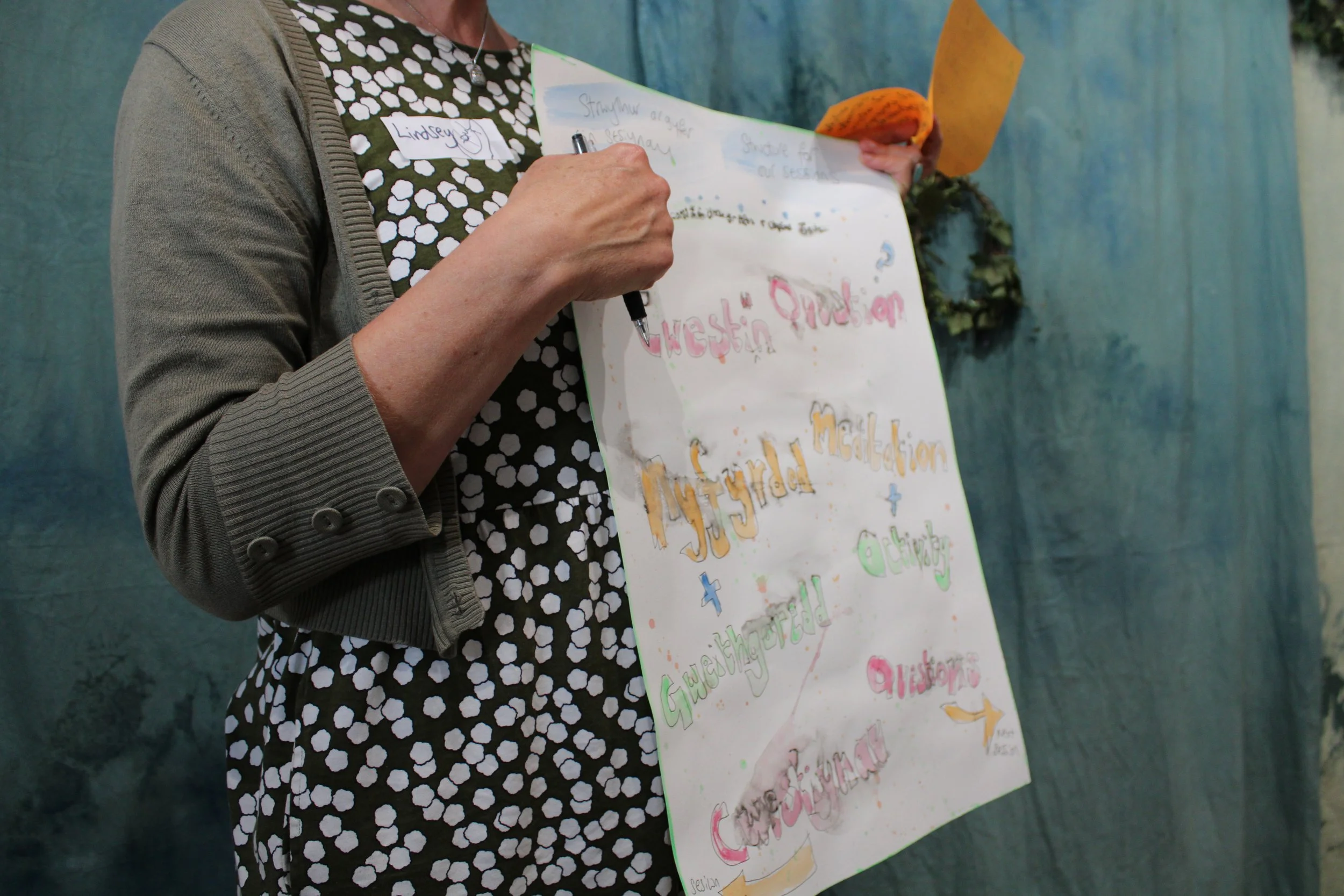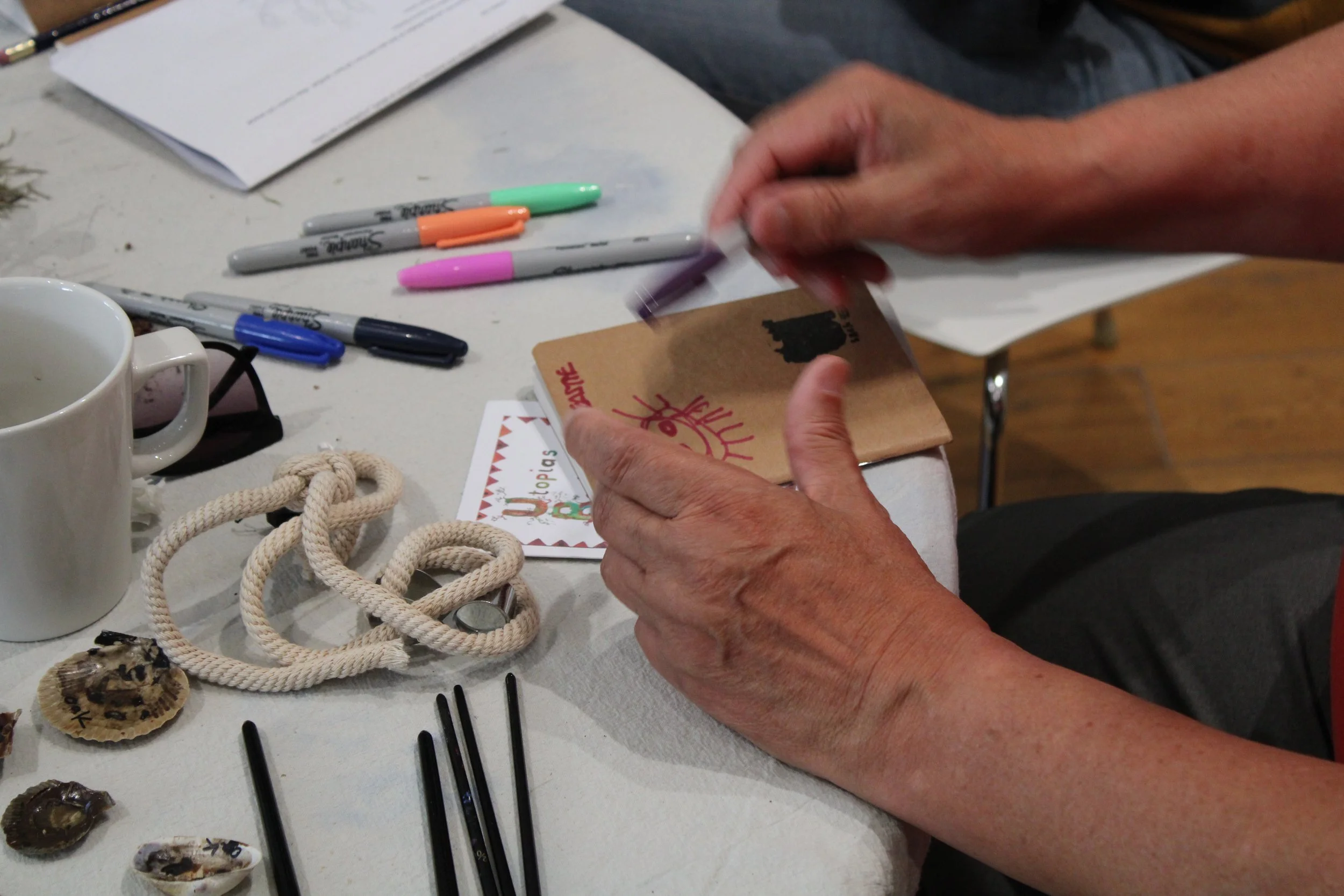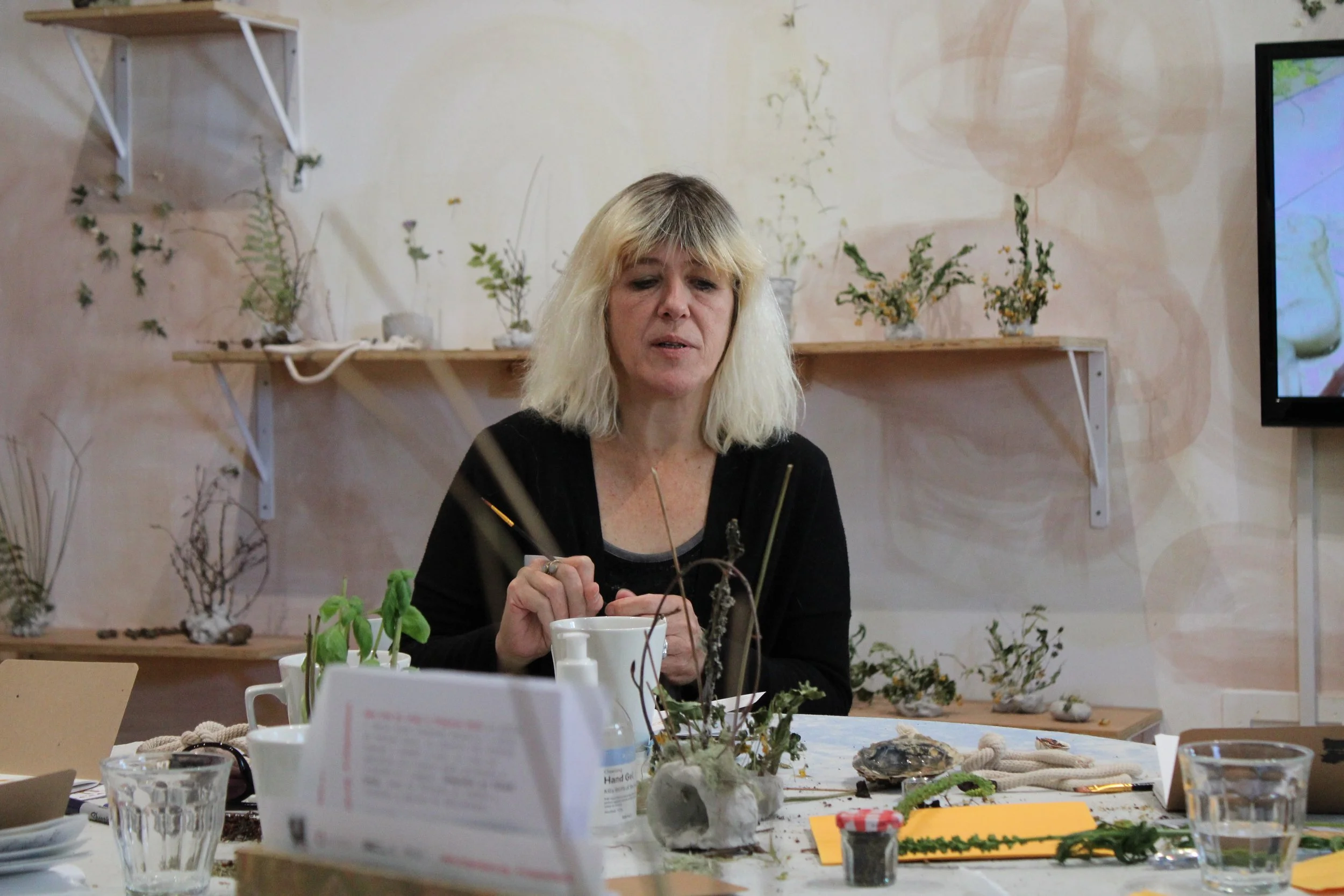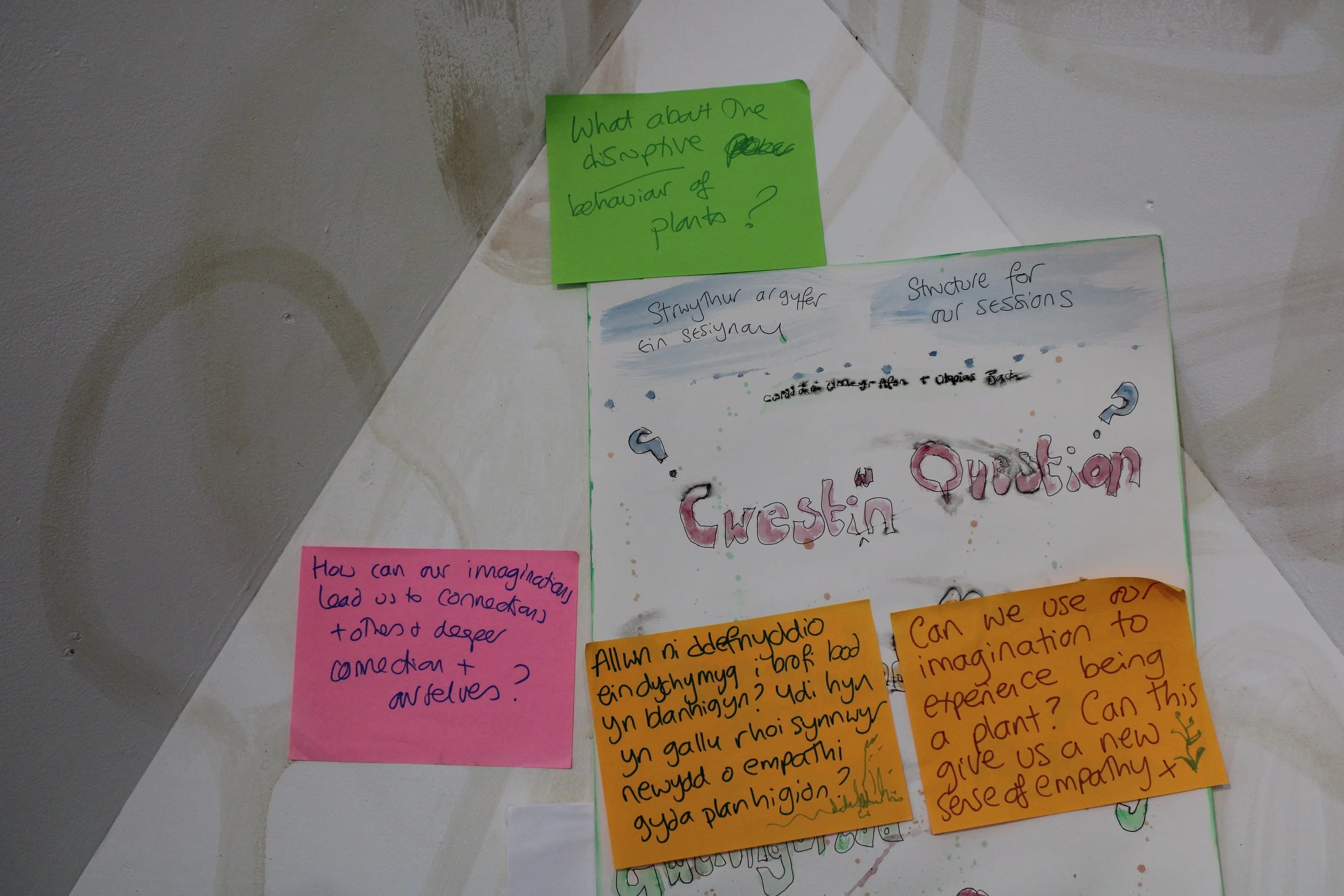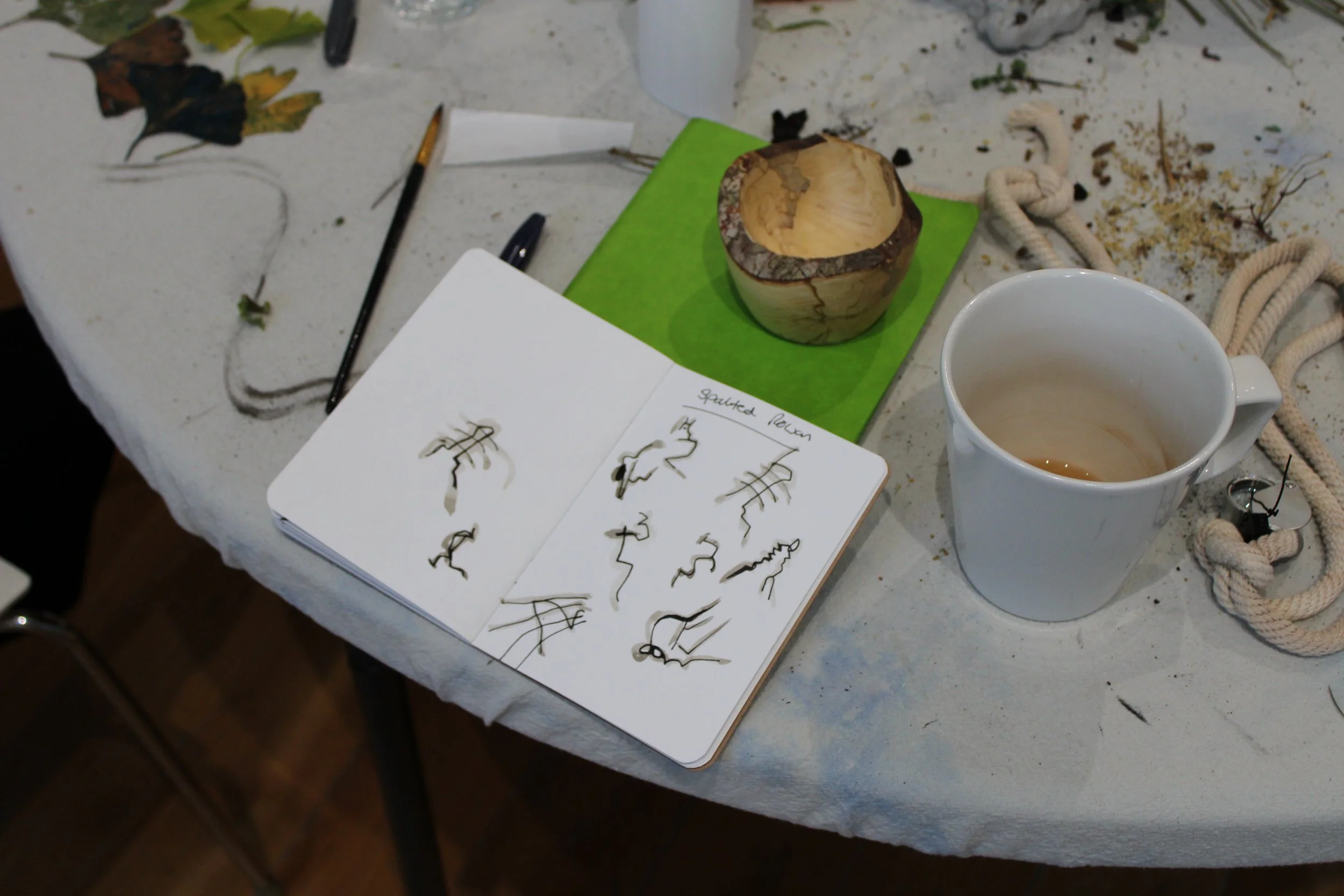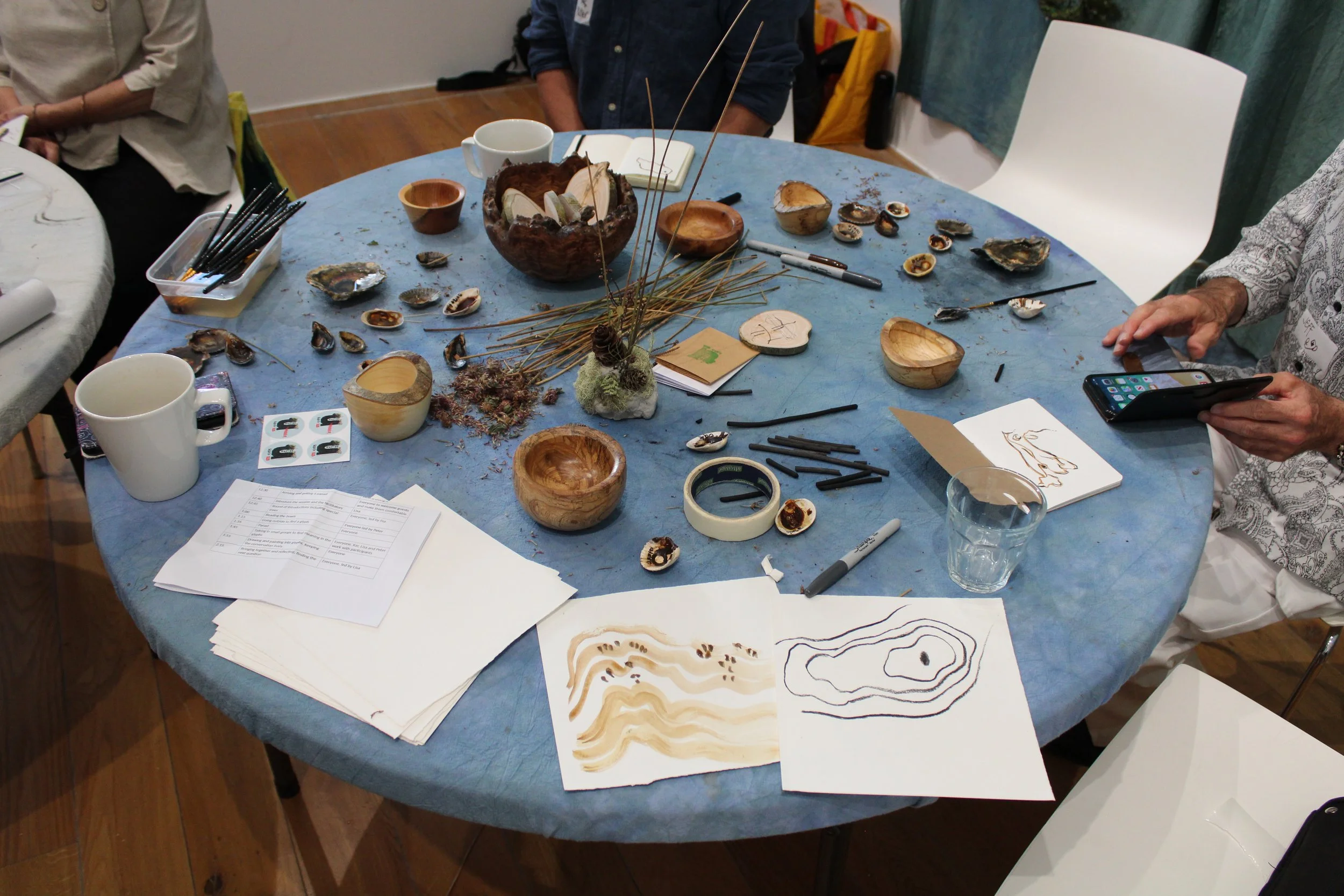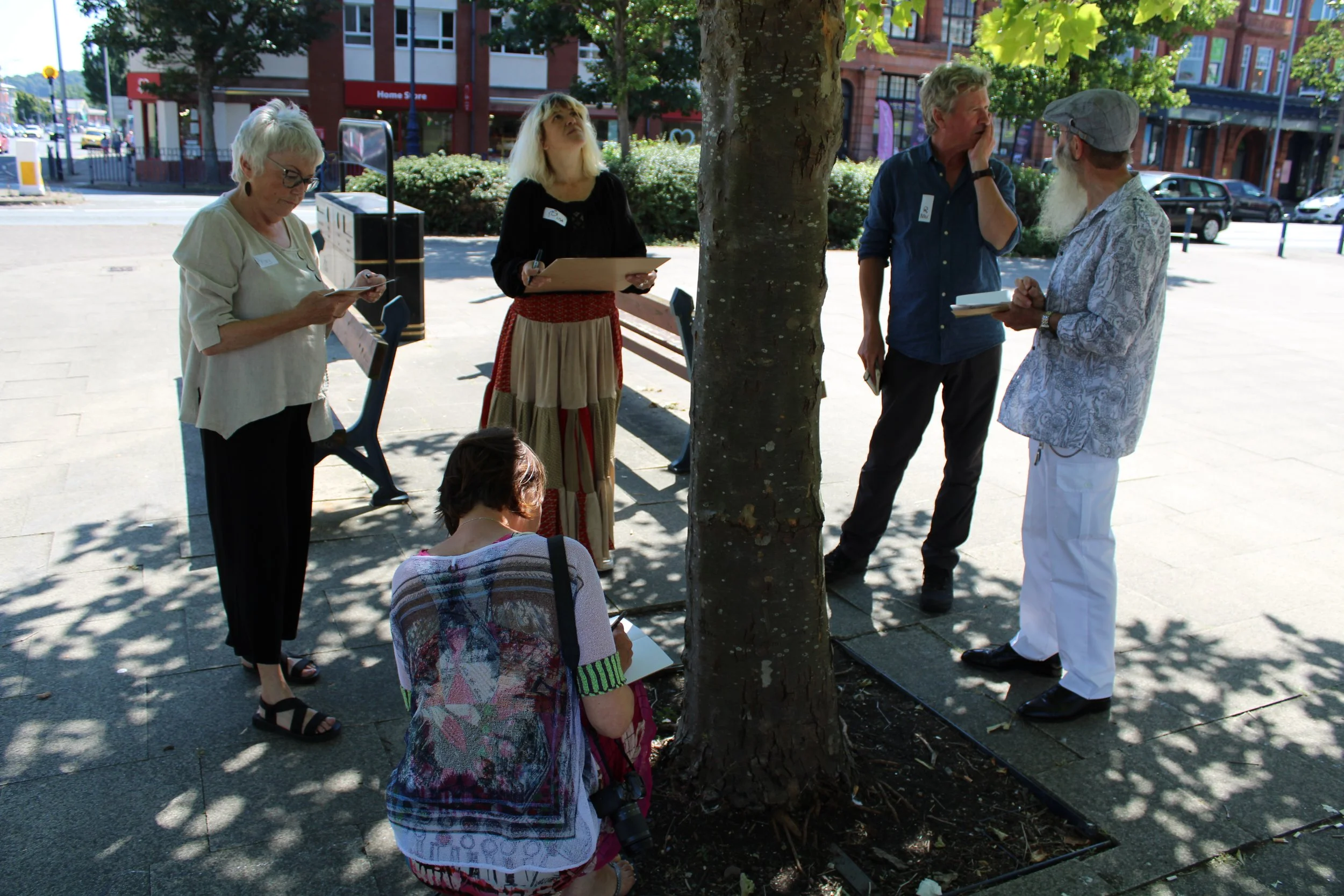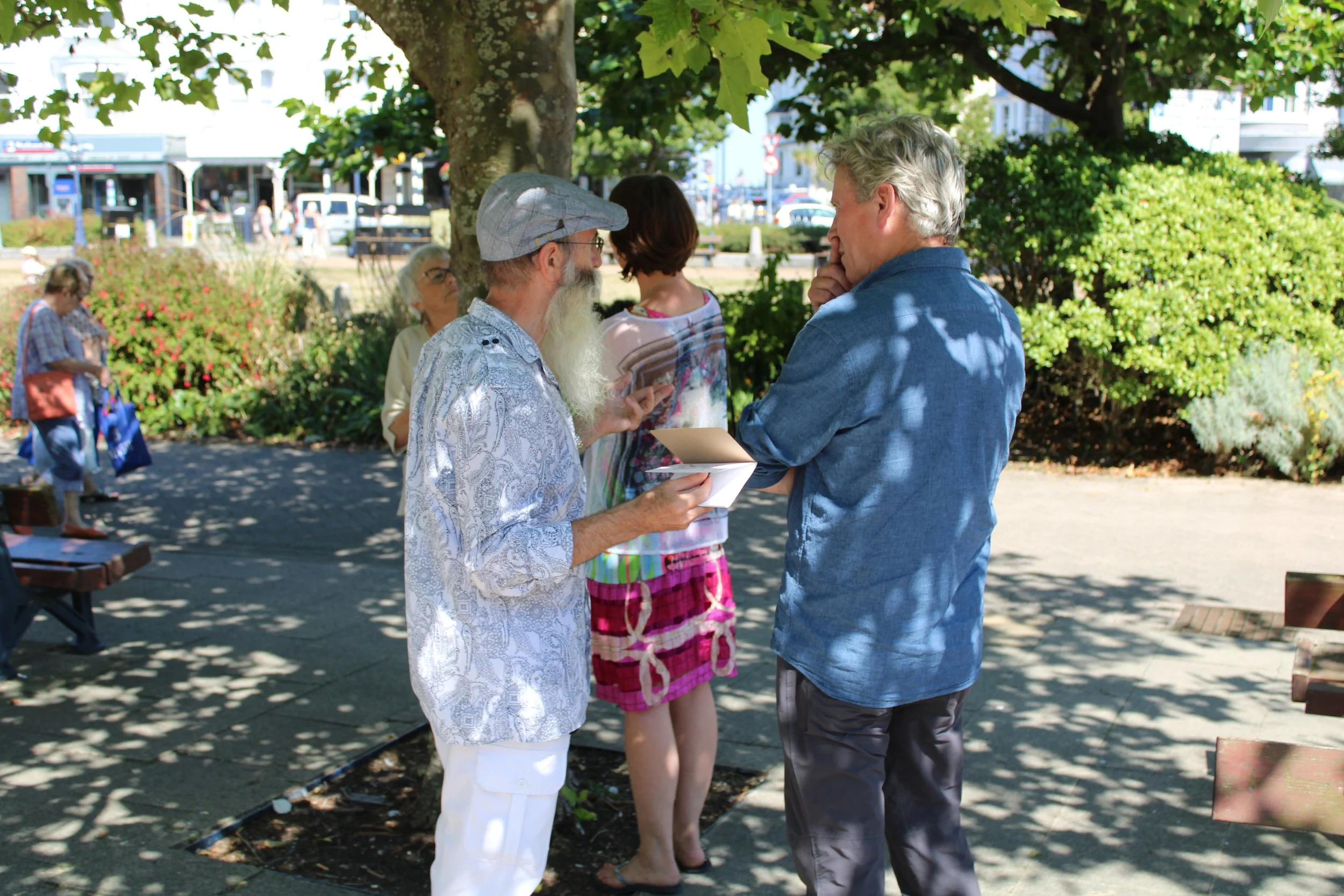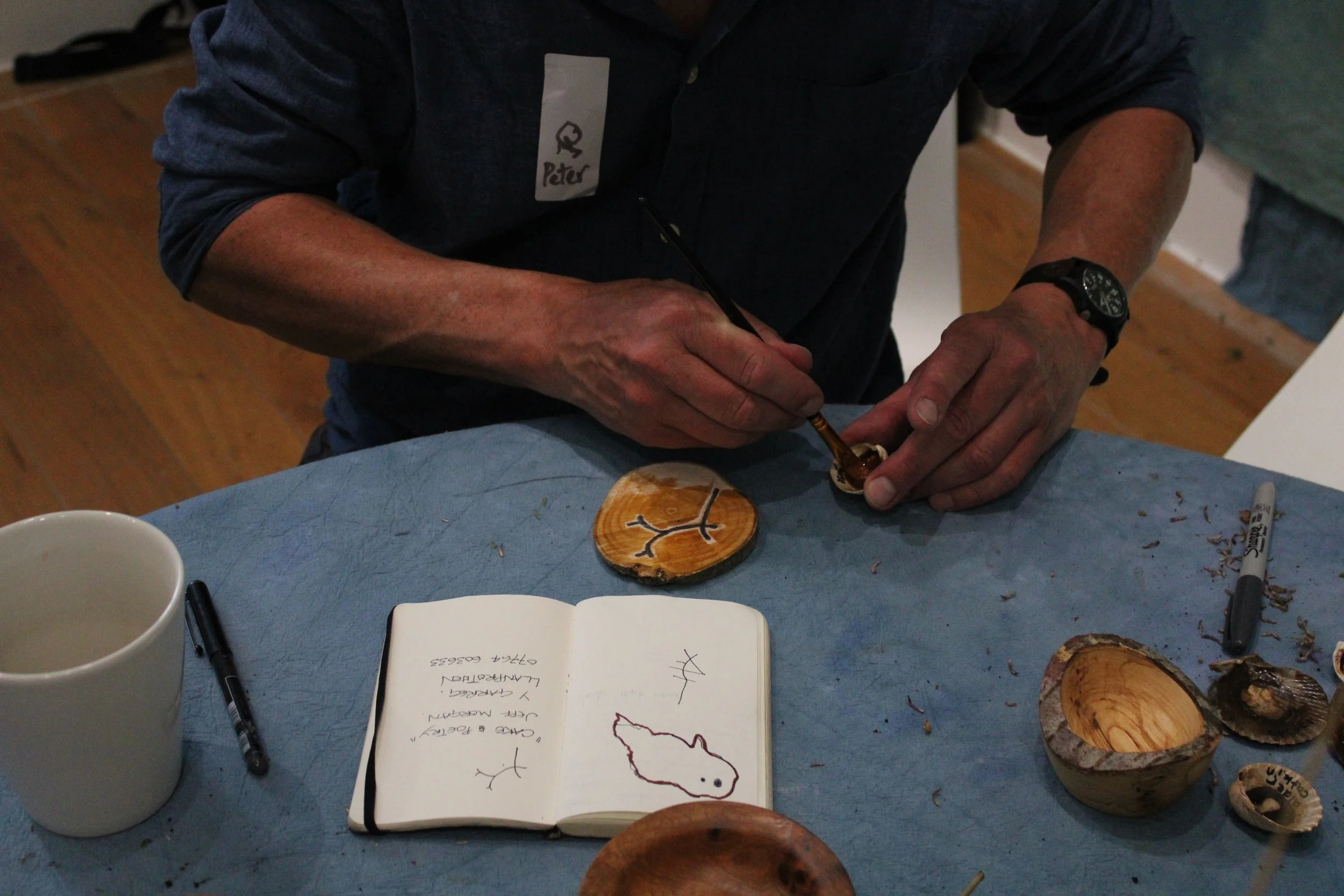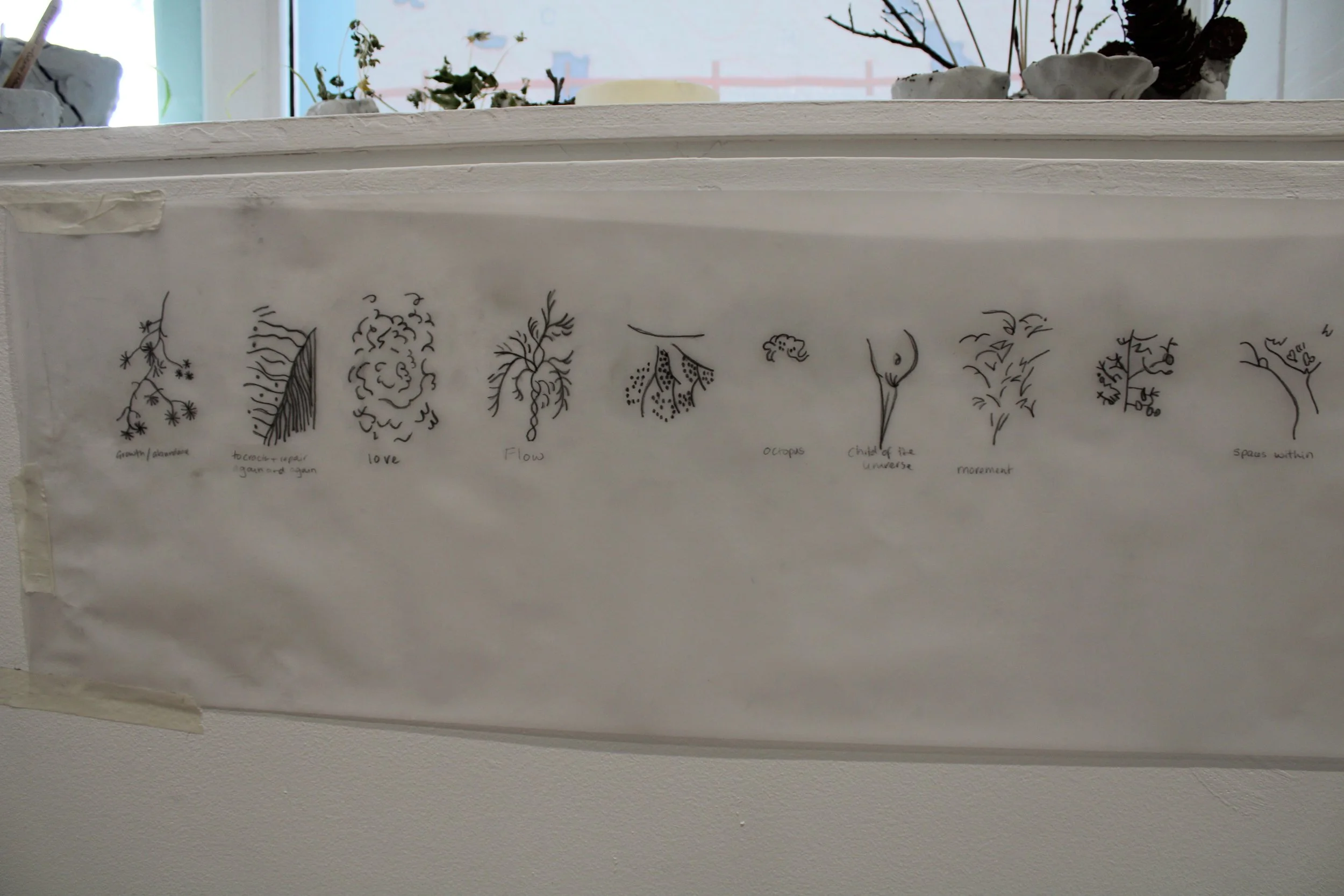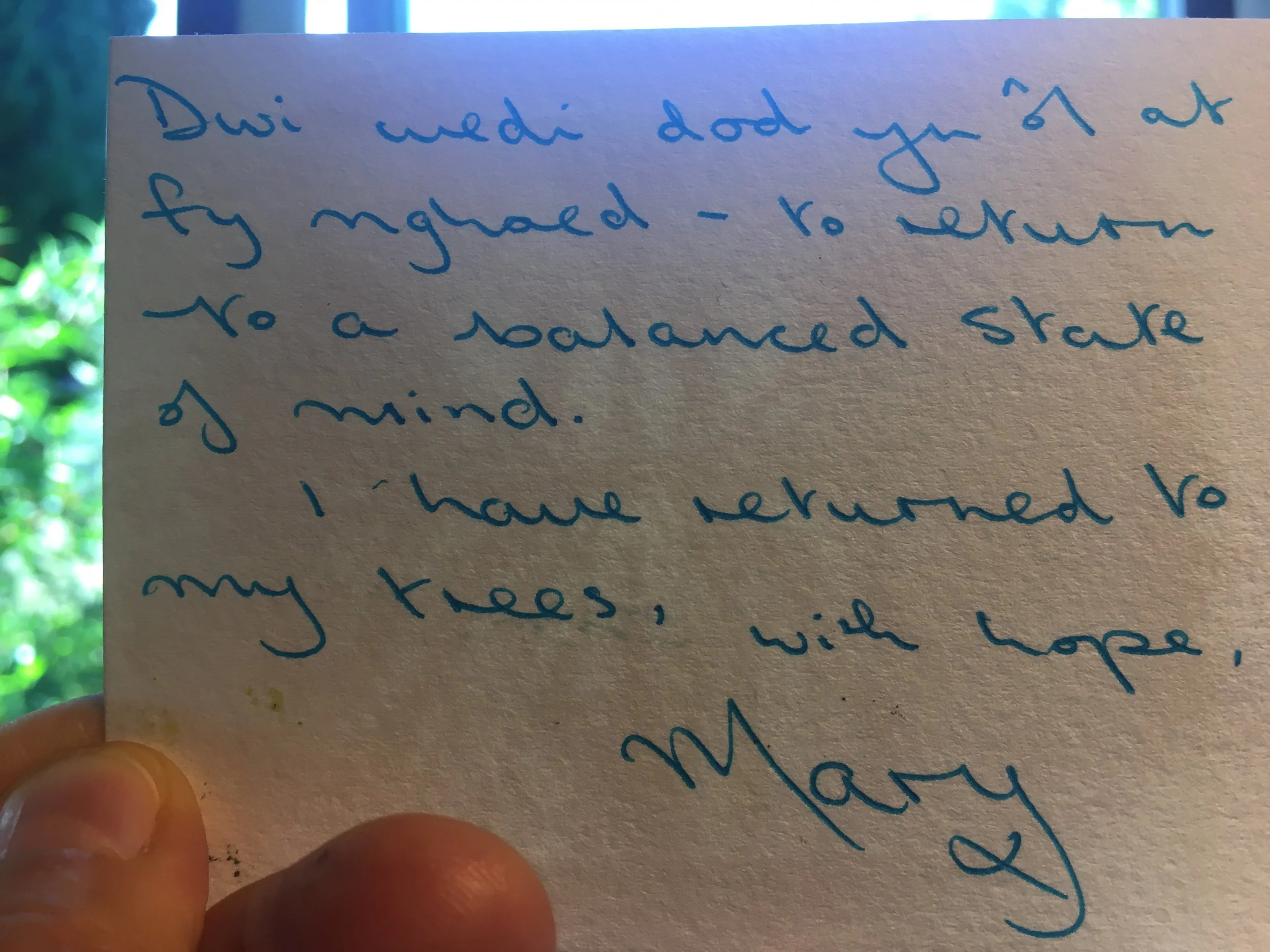
Preswyl Oriel Mostyn Residency
Efo Cwrdd â Ni Wrth yr Afon ac Utopias Bach
DATES: 4 August, 12 August, 18 August, 25 August 2022
TIME: 12:30 – 14:30
Utopias Bach and the people and plants that make up cwrdd â mi wrth yr afon will be part of a collaborative residency throughout the summer to respond to Mostyn’s Project Space commission developed by Mostyn and artist Frances Disley.
During this experimental residency, artists, plants and the club will work together to explore processes that aim to foster deeper connections that bring together the human and more-than-human. In working with the Club over the next four dates in August we’d like to offer the question
“how might we create radical alliances between humans and plants?”
This is inspired by the work the club has already been doing in Cwrdd â Mi Wrth yr Afon, and by Natasha Myers who says
“We need to begin to recognise how we could conspire with the plants – seeding plant-people conspiracies - connecting people and plants together to breathe together, justice for people, their plants, plants and their people”
As a starting point, we have prepared a series of invitations, different ‘ways in’, that we’ll be bringing to each session. These, like our question, are just offers, and we are open to our collaboration going in different directions! We’ll begin each session with a question, and then a meditation and activity, followed by conversation to come up with questions for the next session.
We still have a limited number of spaces for new members of the cwrdd â mi wrth yr afon club. If you are interested in being a part of this project, please contact david@mostyn.org for more details.
This residency is supported by Gwynt Y Môr CVCS funding.
DYDDIADAU: 4 Awst, 12 Awst, 18 Awst, 25 Awst 2022
AMSER: 12:30 – 14:30
Bydd Utopias Bach a’r bobl a’r planhigion sy’n rhan o ‘cwrdd â mi wrth yr afon’ yn rhan o breswyliad cydweithredol drwy gydol yr haf i ymateb i comisiwn Gofod Prosiect Mostyn a ddatblygwyd gan Mostyn a’r artist Frances Disley.
Yn ystod y cyfnod preswyl arbrofol hwn, bydd artistiaid, planhigion a’r clwb yn cydweithio i archwilio prosesau sy’n anelu at feithrin cysylltiadau dyfnach sy’n dod â’r dynol a’r mwy-na-dynol at ei gilydd. Wrth weithio efo’r clwb am y pedwar dyddiad nesaf ym mis Awst, hoffen ni gynnig y cwestiwn
“sut allen ni greu ymgyfuniad radical rhwng bodau dynol a phlanhigion?”
Mae hyn yn cael ei ysbrydoli gan y gwaith y Clwb wedi bod yn ei wneud yn barod yn Cwrdd â Mi Wrth yr Afon, a gan Natasha Myers sy’n dweud
“Mae’n rhaid i ni ddechrau adnabod sut allwn ni gydweithio gyda phlanhigion – hadu cynllwyniau pobl-planhigion – cysylltu pobl a phlanhigion efo’i gilydd i anadlu gyda’i gilydd, cyfiawnder i bobl, eu planhigion, planhigion a’u pobl”
Fel man cychwyn, dan ni wedi paratoi cyfres o wahoddiadau, ‘ffyrdd i mewn’ gwahanol, y byddwn yn dod efo ni i bob sesiwn. Cynigion yn unig ydi’r rhain, fel ein cwestiwn, a dan ni’n agored i’n cydweithrediad fynd i gyfeiriadau gwahanol! Byddwn yn dechrau bob sesiwn efo cwestiwn, ac yna myfyrdod a gweithgaredd, ac yna sgwrs i feddwl am gwestiynau i’r sesiwn nesaf.
Mae gennym nifer cyfyngedig o leoedd o hyd ar gyfer aelodau newydd i’r clwb ‘cwrdd â mi wrth yr afon’. Os oes gennych ddiddordeb mewn bod yn rhan o’r prosiect hwn, cysylltwch â david@mostyn.org am fwy o fanylion.
Cefnogir y cyfnod preswyl hwn gan gyllid Gwynt Y Môr CVCS.
Sesiwn 1 - Trawsffurfiad, guided visualisation
Y cwestiwn Sesiwn 1: “Allwn ni ddefnyddio ein dychymyg i brofi bod yn blanhigyn? Ydi hyn yn gallu rhoi synnwyr newydd o empathi gyda phlanhigion?”
Sesiwn 1 question: “Can we use our imagination to experience being a plant? Can this give us a new sense of empathy with plants?”.
Introductions - weed stories and connections
Instead of doing a ‘round of introductions’ we sent out this invitation to everyone, and then shared our stories…
We would like to invite you to find a weed, and in some way bond with it? This might just be noticing and looking at a weed, or drawing it or photographing it or even planting it in a pot and bringing it with you.
Hoffen ni eich gwahodd chi i ddod o hyd i chwyn, a chysylltu ag o mewn unrhyw ffordd? Efallai mai dim ond sylwi ac edrych arno fydd hyn, neu ei ddarlunio neu ei ffotograffu neu hyn yn oed ei blannu mewn pot a dod ag o efo chi.
Weed stories and connections included ancestral introduction of Himalayan Balsam to Dyffryn Conwy, the healing power of weeds eg selective grazing of animals on herbs (Cae Doctor), the small ambitions of a perfectly formed but only 6 inch Teizel reminding me of being enough, exploring the healing and dying qualities of Dyers Weld growing in a cleared culvert, childhood connections in Wales to Ragwort and the yellow and black caterpillars of the cinnabar moth, changing attitude to Ragwort from ‘dirty’ to ‘desirable diversity’ (from a childhood in Australia - always covered in insects), grandmother pulling out ivy leaved toadflax from the wall and feeling sorry for it, herb robert reminding me of my son and loving the smell, wild strawberry plants as reminding me of Utopias Bach, with its behaviour which might be called weed like - taking over, the calming ritual of the slow process of collecting gorse flowers in Coed Hafod as part of Cwrdd â Ni Wrth yr Afon, as a reminder to slow down, seeing the beauty in weeds and not being able to weed herb plant pots, a basil plant from Lidl as a weedy specimen, representing the way the food system and the whole capitalist system is about producing as much as possible as quickly as possible for max profit and sod everything else, from German language point of view not knowing what weeds are, daisy or dandelion bulbs can be used as caper replacements, are young oak trees sprouting in lawns….
“I’ve got a few statements from my weed: I was planted by another and I thrive here. I am daughter of Arabella. Gardeners call a weed a plant in the wrong place. implying lack of worth. Am I in the wrong place if I am thriving? And whose choice is that? I am an oak with 4 leaves. I am just as valid as any other. I am not in the wrong place. if left here I will become tall and a symbol of strength with my own diverse ecosystem in life and in death. I already am building my mycelium, my circle of community and communication. My supportive tribe.”
What are weeds anyway? ‘Plants in the ‘wrong’ place’? Who decides? No landscape in Britain is completely ‘natural’ - are we ‘managing’, meddling or allowing things to be? Is the disruptive power of weeds a ‘good’ or ‘bad’ thing? Language around ‘Invasive species’ similar in relation to people and plants? Does our attitude to plants in our gardens reflect our attitude to people? Weeds as resilient, adaptive, growing in cracks as a force for change (and an inspiration for humans). The colonial legacy of weeds in Tasmania (eg the blackberry). Does our attitude to weeds need to change in the context of climate change when we don’t know what can survive, what new predators might come here and live on them, so they are no longer a problem? Trees and weeds are existing carbon capture technology.
Trawsffurfiad guided visualisation
“Allwn ni ddefnyddio ein dychymyg i brofi bod yn blanhigyn? Ydi hyn yn gallu rhoi synnwyr newydd o empathi gyda phlanhigion?”
“Can we use our imagination to experience being a plant? Can this give us a new sense of empathy with plants?”.
Utopias Bach has done these Trawsffurfiad guided visualisations in various locations and various groups. We do different versions - the version today is focused on plants but they haven’t always been.
The idea is you can use your imagination to travel in time or space, or to actually become a different being. The idea is that perhaps it can give you a new kind of feeling of empathy, of understanding what it is like to be a different being, exploring their connection with the world.
Here are the visualisations we used in the session, in case you’d like to have a go (apologies for the quality of the Fersiwn Cymraeg - it is from the zoom recording!)
We became… ferns, blackberry, fungus in human guts, tiny plant spores, grasses, flowers, weeds and flows of energies, rhythmns and cells… Some experiences seemed interconnected, and Gaia observed from zoom the interconnected energies in the room. Often we-the-plants were not concerned with what type we were… often we didn’t communicate in (human) language. It was more of a sensory experience, orgasmic in some cases!
“We sat at a distance apart, but were all together in the imaginative space that Seran wove. Even though each of our transformative experiences was uniquely singular, the feeling was communal.”
“the emphasis seemed to be on the sensual, or at least that was the thing that stood out. It felt very joyful and wholesome to be talking about flowers and sex in the same breath.”
Cwestiynau tro nesa: Questions next time
How can our imaginations lead ut to connections with others and a deeper connection with ourselves?
What about the disruptive behaviour (power) of plants?
Sesiwn 2 - TEXTure: Decoding the language of trees
In this session, Lisa Hudson and Peter Hughes took us on a journey through TEXTure, decoding the language of trees.
Our questions for this session
“A allwn ni ddefnyddio ein dychymyg ar y cyd i deall iaith y coed? Can we use our collective imagination to decode the language of trees?”
“Sut gall ein dychymyg ein harwain at gysylltiad ag eraill ac â ein hunain? How can our imagination lead us to a connection to others and to ourselves?”
“What about the disruptive power of plants?”
Reading the bowls
We started by learning to notice and translate the patterns in wooden bowls made by Peter, creating glyphs
Reading the trees
We then went outside and did the same with trees…
Creating glyphs … and decoding them
And back in Mostyn, we chose our glyphs and translated them onto wooden slices, decoding their meaning through conversation
Glyphs and their meanings from previous TEXTure sessions
… and we formulated our question for next time: “How do we go from the individual to the collective, so the whole is greater than the sum of the parts?”
Session 3: Sounding the plants
In this session, Gaia Redgrave invited us to meet and ‘sound’ Lemon Verbena.
Questions y tro ‘ma:
“Can we ‘sound’ the plants? Can we meet them? Be a voice for them? Get their message to the universe?”
“How do we go from the individual to the collective, so the whole is greater than the sum of the parts?”
Meeting Lemon Verbena
Gaia invited us to meet Lemon Verbena. We were asked to look at, smell and taste Lemon Verbena tea, through a tea ritual, slowly exploring Lemon Verbena through a series of invitations. We noticed how it made us feel, what it reminded us of, where does it go in the body, what it would do in the body, what messages Lemon Verbena had for us and what we might do for it in return.
Some words that came up: childhood, home, being cared for, security, postponing judgement, Proustian, all the senses, memory, cleansing, warm, soft, warming the body in different places, oesophogus, kidneys, healthy body, healthy urine, intestine, light, belly, glow, gut, digestive, nourishment, hydration, awakening, mouth, childhood summer, happiness, refreshing, clarity, reaction, reflection, summery, mediterranean, family, gentle togetherness, ritual, medicine, bright, earthy, transient, grounding, calming, relaxing, heart, peace, longlasting, powerful, let go of inhibitions, expansive through the body rather than the mind, dancing.
Sounding Lemon Verbena
At the end of the session, we collectively responded with sounds to the tea. This is a recording of the sound in the room:
Gaia has made soundscape “Meeting Lemon Verbena”, adding her sounding to that in the room, together with the words and responses we generated through discussion:
Quesion next time
“How can we keep what has happened in the last 4 weeks alive in ourselves? Sowing hte seed, keeping the Lemon Verbena dance going…”
Sesiwn 4: Embodied response
In this session, Samina led us in an embodied exploration across the 4 sessions, revisiting each session and the questions we were exploring each time. After each embodied response, we drew a response on a piece of paper
Questions for this session:
How might we create radical alliances with plants? Can we use our imagination to experience being a plant? Does this give us a new sense of empathy with plants?
Can we use our collective imagination to decode the language of trees? How can our imagination lead us to a connection to others and to ourselves? What about the disruptive power of plants?
What was it like to meet Lemon Verbena? What did we learn and experience?
How can we keep what has happened in the last 4 weeks alive in ourselves? Sowing the seed, keeping the Lemon Verbena dance going…
Invitation to the embodied review of the four sessions
If you’d like to try your own version of the embodied review, here is a recording of Samina’s invitations
Images from the session
Feedback after the embodiment
“I feel fucking alive!”
“I felt i was really warm inside, i just felt alive, in touch with everything. it was great. I’ll carry it with me. I was really up for it!”
“More relaxed, grounded.”
“We were all doing this together”
“There was a real energy in here. If you saw it… well we saw it in our drawings”
“I was loving seeing all these different movements. Individual vs the collective - expanding out and seeing the individual and then out to see the collective. It was fascinating”
“There’s a parallel with plants because they are indivdiual but they are sending messages to each other. This was the idea that informed the project in the first place”
What did your embodied movement show you about how can we take this out into the world?
“Passing it on to someone else, as a gift or offering. On a one:one maybe. Or as a network, taking what we’ve done here and offering it to others”
“What I noticed during the movement in answer to this last question was that the movements were all cyclical - its was giving out and taking back simultaneously. You feel like you are living a real life, existing with - its so reciprocal, the more you share the feelings of connecting humans and more than humans, the more that comes back. it never runs out. surfing, remembering that feeling”
“everyone can share positive energy with people. its a good thing to do. its very easy to make people feel happy and good about themselves. during lockdown i really missed touching people. and just people noticing nature, there is so much going on around us it is easy to not notice them, but sometimes you can just notice the smallest thing, like a houseplant’s new leaf of bud. I think you ahve to practice doing it, and then it becomes second nature.”
“Its a lot easier than we think because we can’t help but spread it. Its about realising that we are doing it. It often is in the tiniest gesture. The difficulty we have is not with expressing vitality, its in realising that whatever we do - its just about presence. Asking the building how things can happen, asking nature, asking a plant, an animal.”
“Play! Be with!”
“Noticing - it was teaching me that how i take this out is quieting, deepening my level of presence so i can pay attention to the details. Being curious and seeing the little things. Everything slows down and it is beautiful and wonderous. When we do these activities where we meet non-humans, they infuse us with their wisdom and we take it out - even if it is walking slowly rather than rushing”
“the power of the grassroots - the idea of scale or of things being massive, of things needing to be bigger and bigger especially in an institution that brags about things needing to be really big. There is a real power in working with multiple small scales. Going small and slow and enabling things to take place, it is so important in the idea of co-habiting spaces with multiple organisms. Its like a universal truth, sometimes we don’t need the big things, we need to shut ourselves off this miasma of the superconsciousness global stuff that dampens our ability to connect with each other”"
“Can’t we do this every week?”
“Yes, we can do this at anytime!”
“My foot doesn’t hurt anymore!" Its a miracle!”
Checkout
Samina invited us to share any final reflections on the Utopias Bach/Cwrdd â ni wrth yr afon residency:
“I feel privileged to have met everyone and been on this little voyage of discovery”
“Its been really valuable to me. And meeting you all. i feel i’ve made new friends”
“I am full of gratitue for being involved - its been really inclusive and loving. its worked so well with me on zoom. It’s made me think about in the future it would be good to offer an element online for people who can’t get into the mostyn or wherever for whatever reason. it feels like a positive alternative for more people to join in that wouldn’t be able to otherwise. Personally i have trouble with anxiety and depression and i know that during the times when i’m not so well, having something online where i can participate, it is enriching and fulfilling. I think the lock down has encouraged that to a certain extent, but it would be good to somehow to keep that going and develop it somehow in the future”
“Its been really fun! And surreal in a good way. I feel like the weeds are gathering in the cracks of the institutions”
“For me it was a special day. Despite it being the first time for me, I felt like this was home. It was so relaxing. I hope you guys keep it up”
“I’ve really valued engaging with you all and i’d lke to be involved in anything else that you set up like this”
“I’ve just loved it. Sometimes its been a bit challenging but I feel so empowered. Its like yes i just found it valuable to be here with all of you with this space. This doesn’t happen very often to be heere with people like this to share these experiences, and to pose the questions. I loved it!”
“What i found challenging comes from the tree part - nothing to do with the ideas. it was the actual ‘art’ bit i found challenging. that was all my stuff, it was all to do with uncomfortable and letting going doing a bit of art work and the markmaking. I did it and it was great but once i talked it over at home it was fine. It wasn’t a problem it was a good challenge for me. The next session i came to i thought - this is different to anything i’ve done for a long time, so that’s good! I had no problem today putting my feelings down on paper.”
“I’m so glad i was able to come today. it was such an exquisitely beautiful space to come into. its very much a personal experience but it is also the collective, with other people. i felt very safe, i wasn’t afraid of expressing myself. I didn’t know what we were going to do or how i would respond. It’s like we are tapping into something greater. I feel like i know you all after just one session! These little tiny connections and roots can make all the difference"
“The main thing for me is the connections that mean something, that help with wellbeing really. I have really enjoyed meeting in real life and i’d love to carry on with anything related. So thank you”
“This isn’t closure but a new opening. I totally agree about the comfort of being uncomfortable. The problem with modern society is its too comfortable, no, its too apathetic. We need stimulus like this.”
Diolch i bawb!
You are warmly invited to join Utopias Bach!


